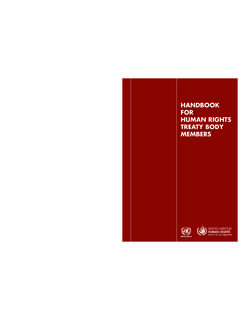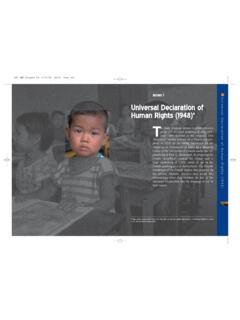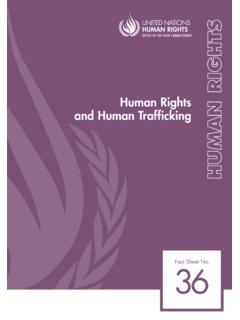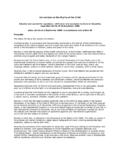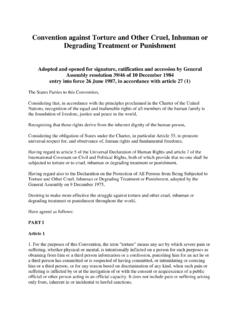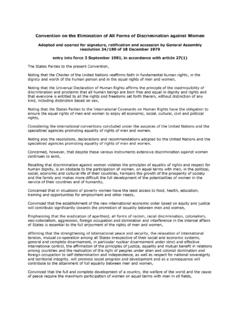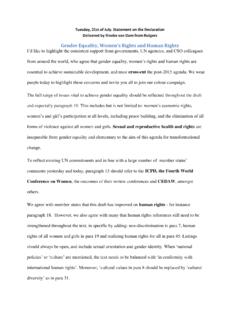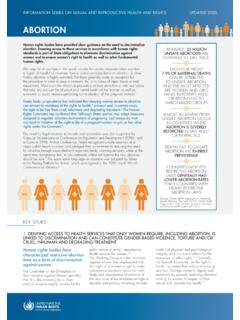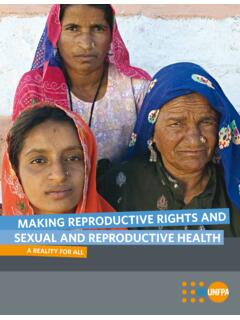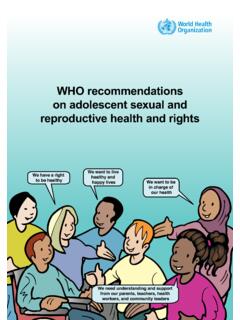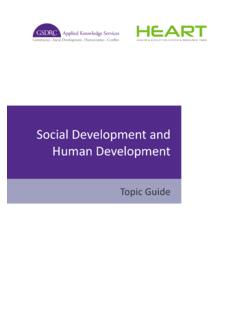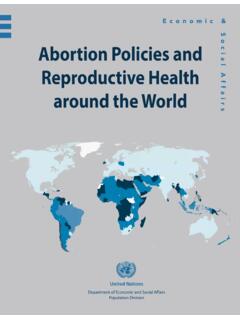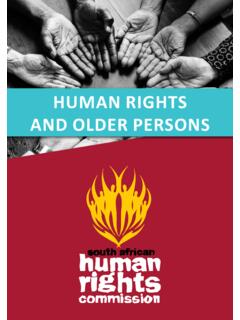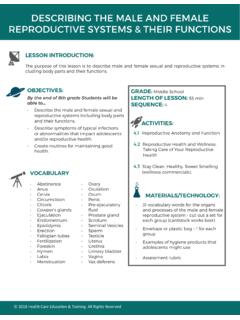Transcription of REPRODUCTIVE RIGHTS ARE HUMAN RIGHTS
1 REPRODUCTIVE RIGHTS ARE HUMAN RIGHTSA HANDBOOK FOR NATIONAL HUMAN RIGHTS INSTITUTIONSREPRODUCTIVE RIGHTS ARE HUMAN RIGHTSA HANDBOOK FOR NATIONAL HUMAN RIGHTS INSTITUTIONSNOTEThe designations employed and the presentation of the material in this publication do not imply the expression of any opinion whatsoever on the part of the United Nations Secretariat concerning the legal status of any country, territory, city or area, or of its authorities, or concerning the delimitation of its frontiers or boundaries. ** *Symbols of the United Nations documents are composed of capital letters combined with figures. Mention of such a figure indicates a reference to a United Nations document. HR/PUB/14/6 2014 United Nations All worldwide RIGHTS reservedAll photographs UNFPAList of Boxes 7 List of Abbreviations 8 The Role of the United Nations Population Fund 10 The Role of the Office of the United Nations High Commissioner for HUMAN RIGHTS 10 The Role of the Danish Institute for HUMAN RIGHTS 11 Acknowledgements 11 Preface 12 Introduction 13 Purpose 13 Key Definitions 18 Content 201.
2 Promoting the REPRODUCTIVE RIGHTS Agenda 21 REPRODUCTIVE RIGHTS are HUMAN RIGHTS 21 Examples of Key Practical Elements of REPRODUCTIVE RIGHTS 22 Understanding Sexual and REPRODUCTIVE Health 24 International Commitments a Historical Overview 242. The National HUMAN RIGHTS Institution Mandate 31 Assessing Workplace Policies and Building the REPRODUCTIVE RIGHTS Competence of Staff 35 Legislative and Administrative Provisions 38 Monitoring and Reporting at the National Level 42 REPRODUCTIVE RIGHTS : A Tool for Monitoring States Obligations 45 Ratification of International Instruments 56 International Reporting 57 Other Forms of International Accountability and Cooperation 60 HUMAN RIGHTS Education and Research 65 Increase Public Awareness 69 Complaints Handling 72 CONTENTS3. Promoting REPRODUCTIVE RIGHTS through a HUMAN RIGHTS -Based Approach to Development 75 Universality, Inalienability, Indivisibility and Interdependence of HUMAN RIGHTS 77 Equality and Non-Discrimination 77 Participation and Inclusion 81 Accountability and Rule of Law 82 The 3AQ Availability, Accessibility, Acceptability and Quality 83 Applying a HRBA to the Development of Policies and Programmes 85 Planning and Budgeting 85 Implementation 87 Monitoring 874.
3 REPRODUCTIVE RIGHTS and HUMAN RIGHTS Standards and Principles 89 Non-Discrimination and Equal Treatment 89 Right to Life 95 Right to Physical Integrity 99 Right to Marry and Found a Family 104 Right to Privacy and Family Life 106 Right to Information and Education 107 Right to the Highest Attainable Standard of Health 109 Right to Benefit from Scientific Progress 114 Further Reading 116 Annex 1: The International HUMAN RIGHTS Treaty Bodies and REPRODUCTIVE RIGHTS 118 Role of Treaty Bodies 118 General Comments or Recommendations 120 HUMAN RIGHTS Committee 120 Committee on Economic, Social and Cultural RIGHTS 124 Committee on the Elimination of all Forms of Discrimination against Women 137 Committee on the RIGHTS of the Child 150 Committee on the Elimination of all Forms of Racial Discrimination 165 Committee against Torture 166 Committee on Migrant Workers 168 Committee on the RIGHTS of Persons with Disabilities 1694 Individual Complaints 169 International Covenant on Civil and Political RIGHTS 170 International Covenant on Economic.
4 Social and Cultural RIGHTS 172 Convention on the Elimination of all Forms of Discrimination against Women 172 Committee on the RIGHTS of the Child 177 Committee on the Elimination of Racial Discrimination 177 Committee against Torture 177 Committee on Migrant Workers 177 Committee on the RIGHTS of Persons with Disabilities 177 Concluding Observations and Recommendations a Synthesis 178 Special Procedures 184 Overview 184 Special Rapporteur on the Right of Everyone to the highest Attainable Standard of Health 185 Special Rapporteur on Violence against Women, its Causes and Consequences 189 Special Rapporteur on the Right to Education 190 Special Rapporteur on the RIGHTS of Indigenous Peoples 191 Special Rapporteur on the Situation of HUMAN RIGHTS Defenders 191 Annex 2: Regional HUMAN RIGHTS Instruments and REPRODUCTIVE Health 192 Africa 192 Conventions 192 The African Commission on HUMAN and Peoples RIGHTS 195 Policy Documents 197 The Americas 201 Conventions 201 The Inter-American Commission on HUMAN RIGHTS 202 The Inter-American Court of HUMAN RIGHTS 203 Reports 204 Europe 205 Conventions 206 The European Court of HUMAN RIGHTS 206 Policies 2085 Annex 3: NHRI Experiences with REPRODUCTIVE RIGHTS 209 Afghanistan 209 Australia 210 Bolivarian Republic of Venezuela 210El Salvador 211 India 212 Jordan 214 Kenya 215 Malaysia 217 Mongolia 217 Namibia 218 Nepal 218 New Zealand 218 Palestine 219 Philippines 219 Portugal 220 Qatar 221 Republic of Korea 222 Senegal 222 South Africa 223 Thailand 224 Timor Leste 224 Uganda 225 Uzbekistan 2266 Box 1.
5 A Brief Situation Description and Key Figures 15 Box 2. Men and REPRODUCTIVE RIGHTS 26 Box 3. HIV/AIDS and REPRODUCTIVE RIGHTS 29 Box 4. NHRIS Commitments to REPRODUCTIVE RIGHTS : the Amman Declaration and Programme of Action 33 Box 5. Collaboration with the United Nations 59 Box 6. Sexuality Education: Promoting REPRODUCTIVE RIGHTS and Gender Equality 67 Box 7. Ageing Women and REPRODUCTIVE RIGHTS 80 Box 8. REPRODUCTIVE RIGHTS and Disabilities 93 Box 9. Religious and Cultural Issues 96 Box 10. Violence against Women and Girls 102 Box 11. New Technology and REPRODUCTIVE RIGHTS 1157 LIST OF BOXESACHPR African Charter on HUMAN and Peoples RightsACHR American Convention on HUMAN RightsAIDS Acquired immunodeficiency syndrome ECHR European Convention on HUMAN RightsFBO Faith-based organizationHIV HUMAN immunodeficiency virusHRBA HUMAN RIGHTS -based approachIACHR Inter-American Commission on HUMAN RIGHTS ICPD International Conference on Population and Develop-ment, Cairo 1994 LGBT Lesbian, gay.
6 Bisexual and transgenderMDGs Millennium Development GoalsMMR Maternal Mortality RateNGO Non-governmental organizationNHRI National HUMAN RIGHTS institutionOHCHR Office of the United Nations High Commissioner for HUMAN RightsSRH Sexual and REPRODUCTIVE HealthSTIs Sexually Transmitted InfectionsUNAIDS The Joint United Nations Programme on HIV/AIDSUNDP United Nations Development ProgrammeUNGA United Nations General AssemblyUNFPA United Nations Population FundUNICEF United Nations Children s FundUN Women United Nations Entity for Gender Equality and the Empowerment of WomenUPR Universal Periodic ReviewWHO World Health Organization8 LIST OF ABBREVIATIONS9 It is the mission of the United Nations Pop-ulation Fund (UNFPA), to deliver a world where every pregnancy is wanted, every birth is safe and every young person s potential is fulfilled. UNFPA s 2014-2017 Strategic Plan furthers this agenda by identifying the agency s goal to achieve universal access to sexual and REPRODUCTIVE health, secure REPRODUCTIVE RIGHTS , and reduce maternal mortality to accelerate progress on the ICPD agenda.
7 UNFPA focuses on improving the lives of adolescents and youth, and women and ensures the integration of HUMAN RIGHTS , gender equality and population dynamics in its work. With respect to HUMAN RIGHTS and gender equality, UNFPA focuses on mainstreaming HUMAN RIGHTS in sexual and REPRODUCTIVE health programming as well as in strengthening national protection systems for advancing REPRODUCTIVE RIGHTS , promot-ing gender equality and non-discrimination, addressing gender-based violence and enhancing accountability. UNFPA is working in the context of its strategic plan to also develop the capacities of National HUMAN RIGHTS Institutions to monitor and protect REPRODUCTIVE RIGHTS . THE ROLE OF THE UNITED NATIONS POPULATION FUNDTHE ROLE OF THE OFFICE OF THE UNITED NATIONS HIGH COMMISSIONER FOR HUMAN RIGHTSThe Office of the United Nations High Commissioner for HUMAN RIGHTS (OHCHR) is mandated to promote and protect the enjoyment and full realization, by all people, of all RIGHTS established in the Charter of the United Nations and in international HUMAN RIGHTS law.
8 It is guided in its work by the mandate provided by the General Assem-bly in resolution 48/141, the Charter of the United Nations, the Universal Declaration of HUMAN RIGHTS and subsequent HUMAN RIGHTS instruments, the Vienna Declaration and Programme of Action of the 1993 World Conference on HUMAN RIGHTS , and the 2005 World Summit Outcome mandate includes preventing HUMAN RIGHTS violations, securing respect for all HUMAN RIGHTS , promoting international coop-eration to protect HUMAN RIGHTS , coordinat-ing related activities throughout the United Nations, and strengthening and streamlining United Nations HUMAN RIGHTS work. In addi-tion to its mandated responsibilities, it leads efforts to integrate a HUMAN RIGHTS approach within all work carried out by the United Nations Danish Institute for HUMAN RIGHTS (DIHR) is Denmark s National HUMAN RIGHTS Institution. It is established by law and mandated to promote and protect HUMAN RIGHTS and equal treatment in Den-mark and internationally.
9 DIHR wishes to set standards and generate change. DIHR bases its international activities on the HUMAN RIGHTS recognized by the international community. Within Denmark, DIHR is the equality body regarding race, ethnicity and gender and the body monitoring the imple-mentation of the United Nations convention on the RIGHTS of persons with Danish Institute for HUMAN RIGHTS pro-tects and promotes HUMAN RIGHTS through partnerships with state, civil society, the business community and independent institu-tions, such as National HUMAN RIGHTS Institu-tions, as well as in strategic cooperation with international and regional actors, including United Nations organs and the International Coordinating Committee of National Insti-tutions for the Promotion and Protection of HUMAN RIGHTS . DIHR works through research, documentation, education, training and com-munication activities. Currently, DIHR is active in Europe, Africa, the Middle East and ROLE OF THE DANISH INSTITUTE FOR HUMAN RIGHTSACKNOWLEDGEMENTSThe Handbook is a joint publication of UNFPA, OHCHR and the Danish Institute for HUMAN RIGHTS .
10 The concept of and overall coordination for the publication was provided by UNFPA. The Danish Institute for HUMAN RIGHTS developed the Hand-book under the direction of Ulrik Spliid and Camilla Silva Fl istrup, with substantive HUMAN RIGHTS input from OHCHR. The partners wish to extend special thanks to the National HUMAN RIGHTS Institutions of South Africa, Uganda, India and the Bolivar-ian Republic of Venezuela for their valuable contributions to the Handbook and partici-pation in a validation workshop in New York, in September 2011. National Institutions from these countries, along with Portugal, El Salvador, Kenya, Namibia, Senegal and Uzbekistan, also provided information on their activities related to REPRODUCTIVE RIGHTS . National institutions from the Asia-Pacific region provided valuable insight during and after the Asia-Pacific Forum in Kuala Lum-pur, in June partners acknowledge the contributions of peer reviewers appointed through inter-nal quality assurance procedures of UNFPA and OHCHR.

